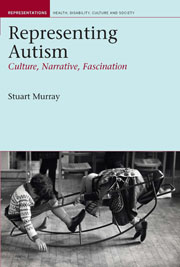Book contents
- Frontmatter
- Contents
- List of figures
- Permissions
- Preface: questions
- Introduction: autism and narrative
- 1 Presences: autistic difference
- 2 Idiots and savants
- 3 Witnessing
- 4 Boys and girls, men and women
- 5 In our time: families and sentiments
- Conclusion: causing/curing/caring
- Acknowledgements
- Select bibliography
- Index
Introduction: autism and narrative
- Frontmatter
- Contents
- List of figures
- Permissions
- Preface: questions
- Introduction: autism and narrative
- 1 Presences: autistic difference
- 2 Idiots and savants
- 3 Witnessing
- 4 Boys and girls, men and women
- 5 In our time: families and sentiments
- Conclusion: causing/curing/caring
- Acknowledgements
- Select bibliography
- Index
Summary
Listening to the radio while driving into work one morning in 2006, I heard an advertisement for a new breakfast show that was about to start on BBC's 6 Music, one of the Corporation's digital channels. The ad itself was mainly a monologue by one of the presenters – I missed the name – full of rapid-fire speech that captured what seemed to be an intended manic personality. I presume the idea was that the programme could be sold by getting any potential audience interested in the personalities of the hosts – pretty much the idea behind any breakfast show. The words didn't make any real impression until I suddenly heard the voice say: ‘I've got OCD and he's got ADHD, so how can you not tune in and listen?’ My response was to be quite startled. As I took that trip to work, I was thinking, in a general sense, through the issues of this book, namely how narrative representations of autism are becoming increasingly common in contemporary culture, and how there seemed to be a public awareness of the condition and others like it that had formed but had not, as yet, really been analysed. Suddenly, listening to the radio, I felt that I was being far too slow in my considerations. Here was a programme in part being sold, quickly and in an almost throw-away manner, precisely because of an assumed public knowledge of neurobehavioural difference, using acronyms that would have been meaningless just a few years before.
- Type
- Chapter
- Information
- Representing AutismCulture, Narrative, Fascination, pp. 1 - 26Publisher: Liverpool University PressPrint publication year: 2008

